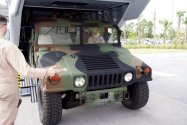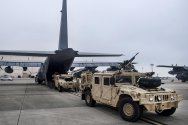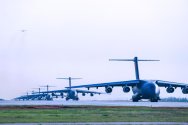Can a light transport aircraft be replaced by aerial logistics drones?Firstly, the Y-8 and Y-9 aren't light by any measure. Tactical yes, but they are medium-sized airlifters.
Regarding the bolded phrase - Yes, I believe they should. While being introduced in 2012, the Y-9 actually stemmed from the roots of the mid-Cold War-era's An-12. Certainly there are some (if not a lot of) aspects and capabilities which can be improved upon, which would better be presented on a brand-new airframe design.
However, it should be noted that the PLAAF isn't exactly in a hurry to procure next-gen medium airlifters, as there are actually more higher priority projects (namely Sino-NGAD, H-20, CCA, newer Gaoxin aircrafts etc) for the PLAAF to dedicate precious resources towards. Moreover, the Y-9 is still very much a proven, versatile and reliable platform to work with, hence this actually leaves more time for the PLAAF to figure out and refine what they really wants from a Y-8/9 family-successor.
Besides, there's the C-130, which was first introduced all the way back in 1956 (i.e. 68 years ago). And it is still getting produced today, with the latest variant (C-130J) first entering service 25 years ago.
Speaking of which, there are three routes which China could go for the PLAAF's next-gen medium airlifters to succeed the Y-8/9 family:
#1 - 4x AEP-500/WJ-10 turboprop-powered (5000kW each) airlifter (equivalent to a more powerful variant of C-130J, estimated ~30-ton max payload); or
#2 - 2x WS-20 turbofan-powered (130-140kN each) airlifter (equivalent to C-390, ~26-ton max payload); or
#3 - 2x up-rated WS-20 turbofan-powered (240-250kN each) airlifter (equivalent to C-2, ~37-ton max payload)
Seems like the current trend of newer medium airlifter developments points towards #2 and #3. But then, there's the A400M which is powered by 4x 8200kW turboprop engines that has similar payload range as the C-2. The A400M entered service just 11 years ago, so it is still quite a new design per se.
So, there's actually more to consider WRT the choices of propulsion.
You are using an out of date browser. It may not display this or other websites correctly.
You should upgrade or use an alternative browser.
You should upgrade or use an alternative browser.
China's transport, tanker & heavy lift aircraft
- Thread starter Totoro
- Start date
Like a 10-ton helicopter, a 25-ton payload tactical transport seems to hit the sweet spot. Given China's high-plateau needs, ease of maintenance, and faster transit time, a domestic C-390 seems to be the best option. It seems all recent tactical transport orders have been C-390s. I would choose 2 C-390s over a single C-2 and I also don't think a Y-9 successor is a priority item.Firstly, the Y-8 and Y-9 aren't light by any measure. Tactical yes, but they are medium-sized airlifters.
Regarding the bolded phrase - Yes, I believe they should. While being introduced in 2012, the Y-9 actually stemmed from the roots of the mid-Cold War-era's An-12. Certainly there are some (if not a lot of) aspects and capabilities which can be improved upon, which would better be presented on a brand-new airframe design.
However, it should be noted that the PLAAF isn't exactly in a hurry to procure next-gen medium airlifters, as there are actually more higher priority projects (namely Sino-NGAD, H-20, CCA, newer Gaoxin aircrafts etc) for the PLAAF to dedicate precious resources towards. Moreover, the Y-9 is still very much a proven, versatile and reliable platform to work with, hence this actually leaves more time for the PLAAF to figure out and refine what they really wants from a Y-8/9 family-successor.
Besides, there's the C-130, which was first introduced all the way back in 1956 (i.e. 68 years ago). And it is still getting produced today, with the latest variant (C-130J) first entering service 25 years ago.
Speaking of which, there are three routes which China could go for the PLAAF's next-gen medium airlifters to succeed the Y-8/9 family:
#1 - 4x AEP-500/WJ-10 turboprop-powered (5000kW each) airlifter (equivalent to a more powerful variant of C-130J, estimated ~30-ton max payload); or
#2 - 2x WS-20 turbofan-powered (130-140kN each) airlifter (equivalent to C-390, ~26-ton max payload); or
#3 - 2x up-rated WS-20 turbofan-powered (240-250kN each) airlifter (equivalent to C-2, ~37-ton max payload)
Seems like the current trend of newer medium airlifter developments points towards #2 and #3. But then, there's the A400M which is powered by 4x 8200kW turboprop engines that has similar payload range as the C-2. The A400M entered service just 11 years ago, so it is still quite a new design per se.
So, there's actually more to consider WRT the choices of propulsion.
Thanks for the clarification C130J is good example of my query , with the limited resources ,it seems to me that next gen medium transport is a nice to have but not a must . would PLAAF seek a replacement for Y8/Y9 family in next 10 years or so consider the lower priority ?
I won't expect successors to the Y-8/9-family to enter service until the mid or late-2030s, at-the-earliest.
Can a light transport aircraft be replaced by aerial logistics drones?
Yes, I do believe that they should start from there. Saves up more pilot resources that would be better allocated for medium and large airlifters, refueling tankers and even bombers.
In that case is medium sized transport is needed anymore ? Isn't heavy lift helicopters like CH-54K , CH-47F are getting to a point that it has long enough range and cargo capacity to change the logistic chain ?Yes, I do believe that they should start from there. Saves up more pilot resources that would be better allocated for medium and large airlifters, refueling tankers and even bombers.
Meaning a heavy transport like C17 or Y20 unloading at an air field at the division level , Helicopters and trucks carry it to the battalions and then drones get it to the companies ?
Looking forward 10 years or so , what capabilities a would a medium transport bring to the table that any other combination platforms can't ?
In that case is medium sized transport is needed anymore ?
Yes, absolutely.
Isn't heavy lift helicopters like CH-54K , CH-47F are getting to a point that it has long enough range and cargo capacity to change the logistic chain ?
Meaning a heavy transport like C17 or Y20 unloading at an air field at the division level , Helicopters and trucks carry it to the battalions and then drones get it to the companies?
Looking forward 10 years or so , what capabilities a would a medium transport bring to the table that any other combination platforms can't ?
That's actually the wrong way of looking at things.
One - Payload weight. The CH-54 is already retired. Its civilian version (i.e. S-64) can only carry up to ~9 tons of payload, whereas the CH-53K has a max payload capacity of ~16 tons. In the meantime, a C-130J can carry up to ~20 tons of payload.
Two - Payload dimension. How big of a payload can be fitted inside a heavy-lift helicopter? One Humvee-sized vehicle at most, but even that is a really tight fit. Meanwhile, the C-130J is able to comfortably carry 3 Humvees inside its cargo hold.
Humvee(s) loaded/unloded into/from a CH-53K (top) and a C-130 (bottom).


Three - Flight performance. Carrying payload inside the fuselage of an aircraft saves more fuel and increases flight performance through the simple fact of eliminating any features that unnecessarily introduces drag. Can heavy-lift helicopters do that while carrying an outsized payload, which can only be done through hanging the payload underneath it?
Four - Speed. The CH-53K can only attain a cruise speed of 170 knots. A C-130J can attain cruise speeds of over 340 knots, i.e. twice as fast. That's a huge difference. Even the V-280 and S-97 can only reach speeds in the high-200s of knots, and they are able to achieve that by having significantly lower payload capacity than the C-130J.
Five - Range. Payload weight and range actually works in opposition, namely more payload = less range and less payload = more range. A CH-53K can fly ~200-300 kilometers while carrying ~12-tons of payload, whereas a C-130J is able to fly 3300 kilometers while carrying ~15 tons of payload. What you're seeing with the higher range values for those heavy-lift helicopters are pretty much useful for ferry flights or carrying light load and fuel onboard only.
Six - Employment. The C-130Js don't just carry payload cargos that can be divided up and distributed. Plus, they can (and actually do) ferry troops and/or equipment close to the frontline combat zones as well, hence their inherent capability to land and take-off from rough, unpaved dirt strips.
Seven - Allocation of airlift resources. The presence of the C-130Js also means that not everything has to be carried by C-17s, and that all those precious C-17 airlifting resources can be better utilized towards ferrying payloads that are actually larger and heavier (such as MRLS and PAC-3).
TL; DR - Heavy-lift helicopters are not the same as medium airlifters, both in performance and roles. Doing so would be trying to substitute apples with oranges.
Last edited:
Thanks for the insight , then what role tactical air lift capability needs to fill in the 2030s and beyond ? My question is thus , in a age of increasing lethality by faster and longer range kill chain , is it feasible that a medium transport still land so close to troops in contact ? How is the medium transport is employed ?Yes, absolutely.
That's actually the wrong way of looking at things.
One - Payload weight. The CH-54 is already retired. Its civilian version (i.e. S-64) can only carry up to ~9 tons of payload, whereas the CH-53K has a max payload capacity of ~16 tons. In the meantime, a C-130J can carry up to ~20 tons of payload.
Two - Payload dimension. How big of a payload can be fitted inside a heavy-lift helicopter? One Humvee-sized vehicle at most, but even that is a really tight fit. Meanwhile, the C-130J is able to comfortably carry 3 Humvees inside its cargo hold.
Humvee(s) loaded/unloded into/from a CH-53K (top) and a C-130 (bottom).
View attachment 137069
View attachment 137068
Three - Flight performance. Carrying payload inside the fuselage of an aircraft saves more fuel and increases flight performance through the simple fact of eliminating any features that unnecessarily introduces drag. Can heavy-lift helicopters do that while carrying an outsized payload, which can only be done through hanging the payload underneath it?
Four - Speed. The CH-53K can only attain a cruise speed of 170 knots. A C-130J can attain cruise speeds of over 340 knots, i.e. twice as fast. That's a huge difference. Even the V-280 and S-97 can only reach speeds in the high-200s of knots, and they are able to achieve that by having significantly lower payload capacity than the C-130J.
Five - Range. Payload weight and range actually works in opposition, namely more payload = less range and less payload = more range. A CH-53K can fly ~200-300 kilometers while carrying ~12-tons of payload, whereas a C-130J is able to fly 3300 kilometers while carrying ~15 tons of payload. What you're seeing with the higher range values for those heavy-lift helicopters are pretty much useful for ferry flights or carrying light load and fuel onboard only.
Six - Employment. The C-130Js don't just carry payload cargos that can be divided up and distributed. Plus, they can (and actually do) ferry troops and/or equipment close to the frontline combat zones as well, hence their inherent capability to land and take-off from rough, unpaved dirt strips.
Seven - Allocation of airlift resources. The presence of the C-130Js also means that not everything has to be carried by C-17s, and that all those precious C-17 airlifting resources can be better utilized towards ferrying payloads that are actually larger and heavier (such as MRLS and PAC-3).
TL; DR - Heavy-lift helicopters are not the same as medium airlifters, both in performance and roles. Doing so would be trying to substitute apples with oranges.
And therefor what specification are preferred for the medium transport.
Does it need to be able to take off from even rougher terrain ? to have more possible landing site
Having longer range ? to be more point to point logistic to avoid concentration of centers of gravity.
Or maybe even stealth to be able to aid in vertical envelopment ?
Thanks for the insight , then what role tactical air lift capability needs to fill in the 2030s and beyond ?
Pretty much similar to what they have been doing for decades, while being better adapted to the 21st-century operational requirements.
My question is thus , in a age of increasing lethality by faster and longer range kill chain , is it feasible that a medium transport still land so close to troops in contact ? How is the medium transport is employed ?
Medium airlifters don't always operate to and from right at the frontlines - Doing that all the time and without reasonable justifications is just plain stupid.
Medium airlifters usually off-load troops, supplies and equipment at friendly FOBs which are typically located some distance away from the combat zones (i.e. reasonably close but not too close), which can then be transported to the combat zones/frontlines by land-based transportations, helicopters or cargo drones, and vice versa for troops and patients.
Those FOBs are to be protected with sufficient, integrated, local and regional AD systems.
And therefor what specification are preferred for the medium transport.
Does it need to be able to take off from even rougher terrain ? to have more possible landing site
The C-130J and Y-9 already have the capability to operate from highway strips and rough, unpaved dirt strips.
But then, nobody is stupid enough to land on paddy fields, in the middle of uncleared forest grounds, in the middle of a swamp or river, and on the slopes of mountains, thanks to the basic laws of physics and engineering. So there's that.
Having longer range ? to be more point to point logistic to avoid concentration of centers of gravity.
The C-130J and Y-9 already have sufficient ranges WRT their operational requirements and nature. Adding even more won't help much - You might as well go with the C-17 and Y-20 (which, again, comes with more requirements and limits concerning operations from non-proper runway surfaces than the C-130 and Y-9).
Or maybe even stealth to be able to aid in vertical envelopment ?
Stealth is pretty much useless once they are close enough to enemy detection systems. We are not in 1991 and 2011 anymore.
Also, going vertical means trading off range and/or payload capacity in order to achieve said capability. The F-35B and Harriers are great examples of this.
Last edited:
You can with the Mi-26 and wasn't that kind of the point of the joint Russian-Chinese replacement for the it?Can heavy-lift helicopters do that while carrying an outsized payload, which can only be done through hanging the payload underneath it?
You can with the Mi-26 and wasn't that kind of the point of the joint Russian-Chinese replacement for the it?
And the Mi-26 still loses out to medium airlifters in pretty much every other metric listed in my prior post (bar max payload weight, but the Y-9 is able to carry ~5 tons more), so there's that.
Also, the joint Chinese-Russian heavy-lift helicopter is actually projected to be smaller than the Mi-26 and closer in terms of performance to the CH-53K.
Last edited:

